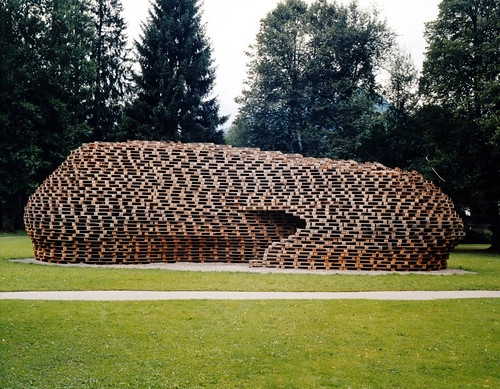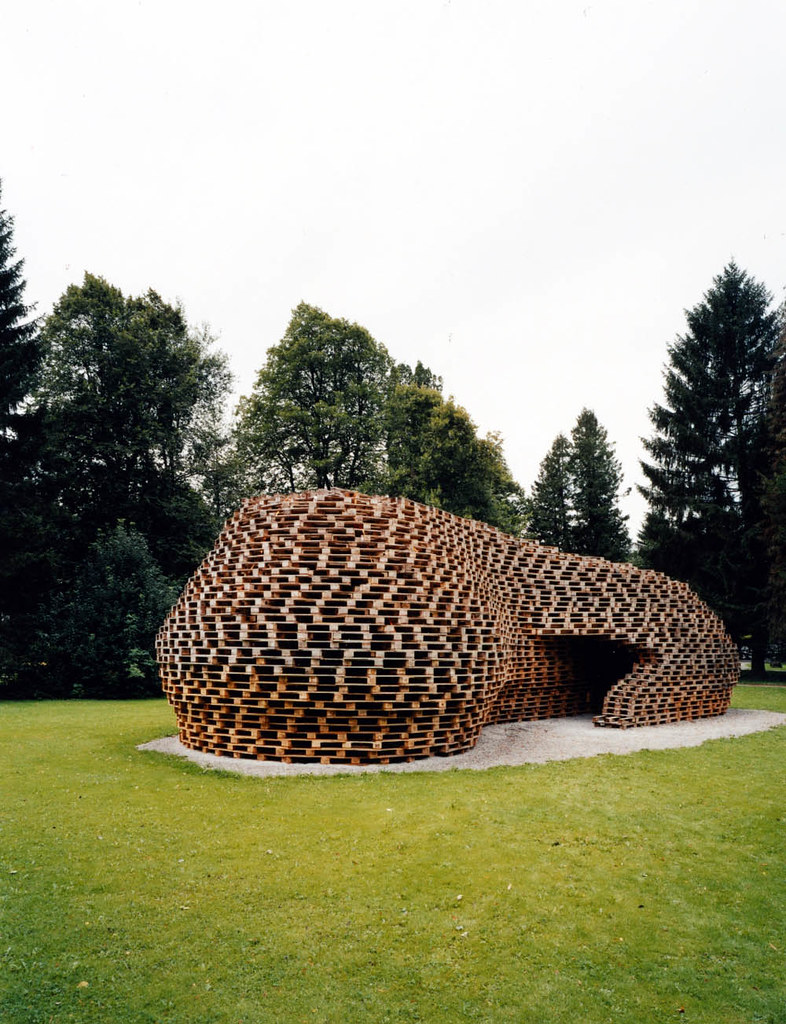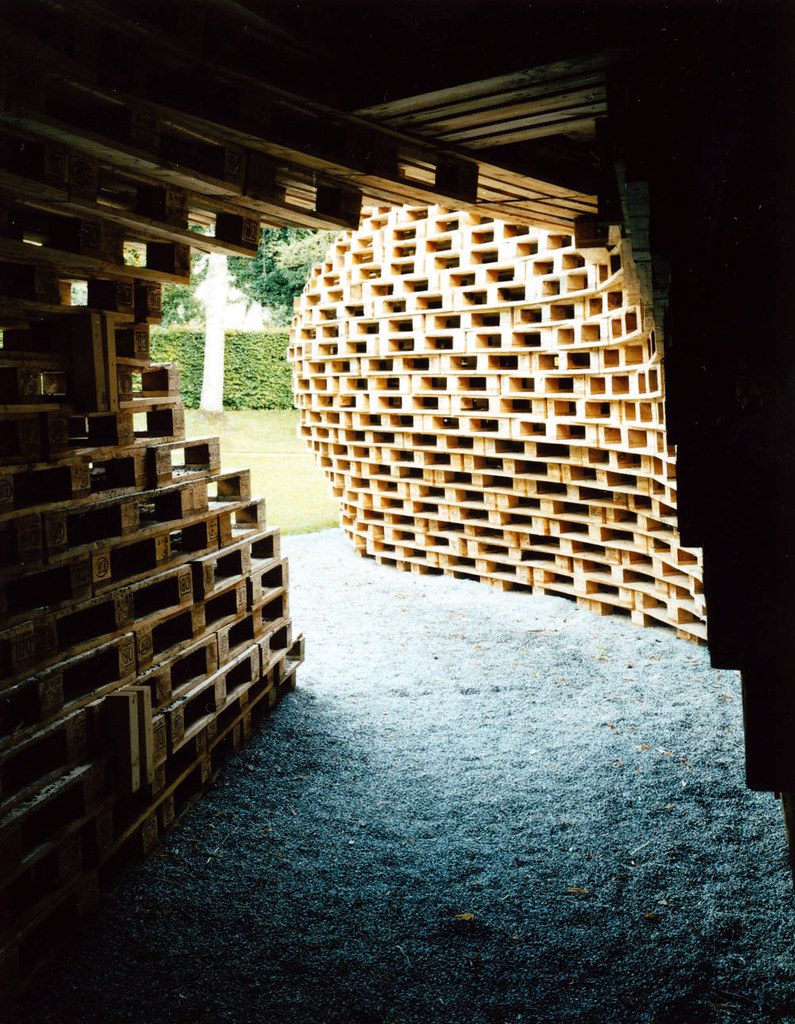Pallet House
 [Image: The Palettenpavillon by Matthias Loebermann, photographed/copyright by Mila Hacke, Berlin].
[Image: The Palettenpavillon by Matthias Loebermann, photographed/copyright by Mila Hacke, Berlin].The Palettenpavillon by Matthias Loebermann is a structure made entirely from shipping pallets, ground anchors, and tie rods. Designed to be easily assembled and dismantled, and then entirely recycled at a later date, the resulting building is intended as a temporary meeting place.
 [Image: The Palettenpavillon by Matthias Loebermann, photographed/copyright by Mila Hacke, Berlin].
[Image: The Palettenpavillon by Matthias Loebermann, photographed/copyright by Mila Hacke, Berlin].As the architect writes, the shipping pallets are "characterized by a complex geometry of open and closed surface portions," with the effect that a staggered stacking of each unit produces "interesting netlike structures." They add that the deceptively curvilinear form becomes a "cave."
 [Image: The Palettenpavillon by Matthias Loebermann, photographed/copyright by Mila Hacke, Berlin].
[Image: The Palettenpavillon by Matthias Loebermann, photographed/copyright by Mila Hacke, Berlin].The unexpected modular reuse of everyday materials is nothing new in architecture—seemingly every term in architecture school brings with it experiments in the tiling of things like cable ties, styrofoam cups, plastic water bottles, and so on—but the spatially dramatic effects of this particular experiment in large-scale, off-kilter pallet-stacking are worth seeing. In fact, a kind of micro-village of equally fluid forms built entirely from pallets would be fascinating to see.

 [Images: The Palettenpavillon by Matthias Loebermann, photographed/copyright by Mila Hacke, Berlin].
[Images: The Palettenpavillon by Matthias Loebermann, photographed/copyright by Mila Hacke, Berlin].The pavilion at night, lit from within, is also pretty eye-popping—though it might be interesting to see if there's some strange way to turn the whole structure into a stationary zoetrope of some sort, i.e. the light shining outward is given content, projecting images on the landscape outside. The pallet building as planetarium-machine.
 [Images: The Palettenpavillon by Matthias Loebermann, photographed/copyright by Mila Hacke, Berlin].
[Images: The Palettenpavillon by Matthias Loebermann, photographed/copyright by Mila Hacke, Berlin].On the other hand, perhaps pallet architecture is not universally interesting; this recent experiment in London is what Jonathan Glancey calls "a shrine to the humble timber pallet."
- Until a few weeks ago, these hundreds of pallets were being used to stack fruit and vegetables in Covent Garden market. Cheap, strong and hugely adaptable, they also happen to have a distinctly architectural look, especially when flipped on their sides and turned into walls. Some will be left as they are, others clad with sheets of plywood to keep the rain out and to usher in the darkness needed inside an auditorium.
In any case, for more info on the Palettenpavillon—albeit in German—stop by Loebermann's website.





Comments are moderated.
If it's not spam, it will appear here shortly!
In one word: beautiful... (Inspiring too.)
I'm sure it occurs elsewhere but in Northern Ireland, every 12th of July, there are huge bonfires built all over the country out of these pallets (and to a lesser extent various other wooden/flammable debris). Despite the inevitable burning of all these structures they are carefully built to ensure they are relatively safe (many are built along busy roads in Belfast) and as tall as possible. I have never really cosidered an architectural aspect to these until now. It would be interesting to hear your opinion Geoff! I would send a link to youtube only I can't find any without heavily sectarian overtones.
It works wonderfully as a sculptural object, but fails abjectly as even a "temporary" building. A gazebo would do a better job at keeping the weather out- why pretend it has practical qualities when it is a beautiful (and inexpensive!) avant garde garden folly?
Oh! Here you go! Beautiful... That's the keyword.
"Whether you come from heaven or hell, what does it matter, O Beauty!"
Charles Baudelaire
Very cool, looks like corrugated cardboard
Love the texture in this piece.
Reminds me of a project that a tutor once issued;
a house as a light.
light as a house.
brilliant.
This is a great way to get sick and/or cancer!
Wood pallets carry serious pathogens and chemicals.
http://www.pallettruth.com/2010/07/would-you-let-your-child-sleep-on-a-wooden-pallet/
Hmmm, www.pallettruth.com is copyrighted by another website dedicated to driving the sale of plastic products.
As anyone who's worked in a shipping dock will tell you, wooden pallets are also rarely so uniform in quality, appearance, stability, etc. It's not unusual for even a modest stack of the things to be horribly unstable, and even flat-out dangerous. They also don't last very long 'in the field', as it were; most of their value lies in how cheap and disposable they are. They don't hold up well. You'd be hard-pressed to find that many pallets that were ready for re-use. Any pallet in good enough shape to build with isn't ready to be discarded yet.
You couldn't pay me to walk through that 'building'.
James and Geoff,
David Schalliol has some chilling photos of the Belfast pallet pyres from this past July 12th here: http://www.flickr.com/photos/metroblossom/4781631892/in/set-72157624467003926/
Grkw, here is a particularly good photo from Schalliol's series.
Absolutely love all architecture that involves the use of recycled materials, even for the sake of art - of which this is a beautiful piece.
These temporary dwellings are reminiscent of the caves in Cappadocia, Turkey. I loved how a simple palette, and the lighting that dances from its openings, can bring me back to such a beautiful place in an instant.
I find it rather sad that a building which is beautiful but completely useless merits a post and six photographs, but that a structure which is actually useful is "not [...] interesting" and unmoving. What is a building for if it is not for something? What is architecture for if it is not for something?
And i'm sure you know your semiotics from your semipermanents and your post-structuralism from your structural posts very well, but perhaps i could point out that those vertical things at the edges of the building which keep the weather and the noise out aren't "references to walls", they're walls!
Gorgeous, totally gorgeous. Kudos to Mila Hacke for capturing the project very nicely.
I'm with you on that one in Southwark, it's rubbish.
How to transform a humble object into art.
Someone commented that architecture is for something... in this case obviously the purpose is to express and inspire beauty. I cannot think of a higher purpose than that...
Finally a pallet house that isn't a dilapidated box!
Fascinating!
I very much like this project, practical or not. It is especially interesting in the night shot. Thanks for the commentary.
Grkw Thanks for the link!
Having been involved in 'that one in southwark'... you are totally right it is rubbish.. entirely rubbish infact. thats the whole concept
perfectly intact pallets all of the same dimension are hard to come by so we had to put to use a wide variety of pallet sizes at varying levels of decay. this provides big drawbacks in being able to explore the geometric qualities of the crates. use as a cladding material seemed an obvious choice.
Our project may not be as beautiful as the other mentioned but having volunteered for some months building it it seems to have been more about community engagement than architectural merit... it has got diverse hoards of people talking in the area and will continue to do so now that the theatre is open.
PLEASE some one tell me you can build a house to "code" with shipping pallets!
There are very few reasons that a double thick wall, that is cross grained,, would not would completely surpass standard 2x4 codes..
Yes if you built it out of bad ones it would make a inferior wall..
but if you made it out of good ones and used plenty of glue...
..yah know?..
..and by the way, i built a 'earthquake test model building" that surpassed the record to the point where we didn't have any more standard weights to use, nor a higher vibration setting!
On top of that, the models allays take damage - mine didn't, and i built it on my own!
- (lazy group members)
Besides I have been doing stuff like that my whole life.
So dont tell me i dont know something about this!
..you pessimists.. heh(lol)
It's trippy to look at. Practically speaking not so good. Weather is going to be comparable to the outside minus the sun or rain. Not to mention it will do a sufficiently descent job of keeping the toxic fumes from circulating (most pallets are filled with chemical toxins). And last but not least, a cigarette flicked during the wrong time of year, or more maliciously an a couple of ounces of gasoline and a match would be catastrophic.
Post a Comment